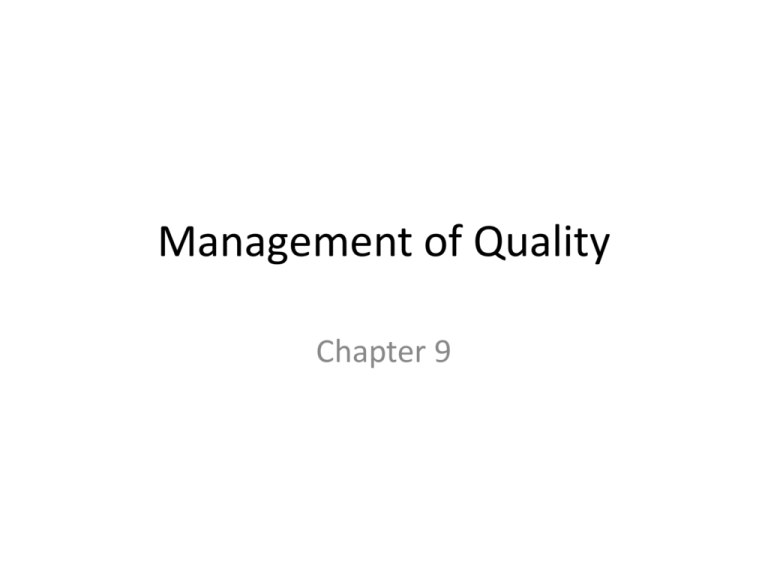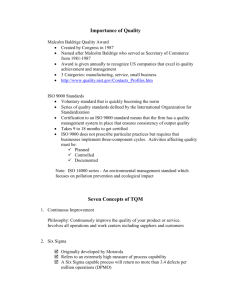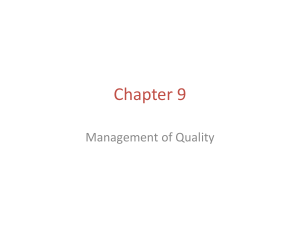Management of Quality - U
advertisement

Management of Quality Chapter 9 GM Recall • http://www.cbsnews.com/videos/gm-recalls8-2-million-more-cars/ • Work as a group and prepare to answer the following questions: – What is the defect? – How many have GM recalled? – (discussion) Will GM survive? Learning Objectives • Define the term quality as it relates to products and as it relates to services. • Identify the determinants of quality. • Explain why quality is important and the consequences of poor quality. • Describe TQM. • Describe and use various quality tools. Quality Management • For a decade or so, quality was an important focal point in business. After a while, this emphasis began to fade as other concerns took precedence • There has been a recent resurgence in attention to quality given recent experiences with the costs and adverse attention associated with highly visible quality failures: – – – – – Auto recalls Toys Produce Dog food Pharmaceuticals • Quality – The ability of a product or service to consistently meet or exceed customer expectations Dimensions of Product Quality • • • • • • • • • Performance—main characteristics of the product Aesthetics—appearance, feel, smell, taste Special features—extra characteristics Conformance—how well the product conforms to design specifications Reliability—consistency of performance Durability—the useful life of the product Perceived quality—indirect evaluation of quality Servicebility—handling of complaints or repairs Consistency—quality doesn't vary. Dimensions of Service Quality • Convenience—the availability and accessibility of the service • Reliability—ability to perform a service dependably, consistently, and accurately • Responsiveness—willingness to help customers in unusual situations and to deal with problems • Time—the speed with which the service is delivered • Assurance—knowledge exhibited by personnel and their ability to convey trust and confidence • Courtesy—the way customers are treated by employees • Tangibles—the physical appearance of facilities, equipment, personnel, and communication materials • Consistency—the ability to provide the same level of good quality repeatedly • Expectations—Meet (or exceed) customer expectations. Determinants of Quality • Quality of design – Intention of designers to include or exclude features in a product or service • Quality of conformance – The degree to which goods or services conform to the intent of the designers • Ease-of-Use and user instructions – Increase the likelihood that a product will be used for its intended purpose and in such a way that it will continue to function properly and safely • After-the-sale service – Taking care of issues and problems that arise after the sale Benefits of Good Quality • • • • • • • • Enhanced reputation for quality Ability to command premium prices Increased market share Greater customer loyalty Lower liability costs Fewer production or service problems Lower production costs Higher profits The Consequences of Poor Quality • • • • Loss of business Liability Productivity Costs (e.g., repair, replacement) The Costs of Quality • Appraisal Costs – Costs of activities designed to ensure quality or uncover defects • Inspectors, testing, test equipment, labs, quality audits, quality control, field testing • Prevention Costs – Cost of preventing defects from occurring • Planning, administration, working with vendors, training, quality assurance, design and production. • Failure Costs – Costs incurred by defective parts/products or faulty services. – Internal Failure Costs • Costs incurred to fix problems that are detected before the product/service is delivered to the customer. – External Failure Costs • All costs incurred to fix problems that are detected after the product/service is delivered to the customer Costs of Quality Total Cost Total Cost External Failure Internal Failure Prevention Appraisal Quality Improvement MIS 373: Basic Operations Management 12 Case Study • Toyota settles with government for $1.2 billion in recall probe (washingtonpost.com 3/19/14) – In 2009, the driver of a borrowed Lexus — made by Toyota — was unable to stop the vehicle as it careened off the highway at 120 miles per hour, killing three people. “There’s no brakes…Hold on and pray,” one of the passengers said to a 911 operator. – Toyota Motor Corp. has agreed to a $1.2 billion settlement to end a U.S. Justice Department criminal probe into its handling of safety problems, Attorney General Eric Holder announced. – “The $1.2 billion payment represents the largest criminal penalty imposed on a car company in U.S. history,” Holder said in a statement. “This is appropriate given the extent of the deception carried out by Toyota in this case. Put simply, Toyota’s conduct was shameful,” Holder said. Responsibility for Quality • Everyone in the organization has some responsibility for quality, but certain areas of the organization are involved in activities that make them key areas of responsibility • • • • • • • • Top management Design Procurement Production/operations Quality assurance Packaging and shipping Marketing and sales Customer service Quality Certification • ISO 9000 – Set of international standards on quality management and quality assurance, critical to international business • ISO 14000 – A set of international standards for assessing a company’s environmental performance • ISO 24700 – Pertains to the quality and performance of office equipment that contains reused components – A Marketed product that contains reused components performs equivalent to new. ISO 9000 series standards • ISO 9000 – International recognition – Encourages quality management procedures, detailed documentation, work instructions, and recordkeeping – Applies to any organization regardless of size or industry – Over one million certifications in 178 countries – Critical for global business – Includes ISO 9000:2005 (definitions), ISO 9001:2008 (requirements) and ISO 9004:2009 (continuous improvement) ISO 9000 series standards • Management principles – Top management leadership – Customer satisfaction – Continual improvement – Involvement of people – Process analysis – Use of data-driven decision making – A systems approach to management – Mutually beneficial supplier relationships Total Quality Management • A philosophy that involves everyone in an organization in a continual effort to improve quality and achieve customer satisfaction. • TQM approach 1. 2. 3. 4. 5. 6. Find out what the customer wants. Design a product or service that meets or exceeds customer wants. Design processes that facilitate doing the job right the first time. Keep track of results. Extend these concepts throughout the supply chain. Top management must be involved and committed. Elements of TQM • • • • • • • • • • Continuous improvement Competitive benchmarking Employee empowerment Team approach Decisions based on facts rather than opinions Knowledge of tools Supplier quality Champion Quality at the source Suppliers BMW QUALITY MANAGEMENT Can we identify the TQM elements from this video? •Continuous improvement •Competitive benchmarking •Employee empowerment •Team approach •Decisions based on facts rather than opinions •Knowledge of tools •Supplier quality •Champion •Quality at the source •Suppliers PDSA Cycle • Plan-Do-Study-Act (PDSA) Cycle – Plan • • • • Begin by studying and documenting the current process. Collect data on the process or problem Analyze the data and develop a plan for improvement Specify measures for evaluating the plan Act Plan Study Do – Do • Implement the plan, document any changes made, collect data for analysis – Study • Evaluate the data collection during the do phase • Check results against goals formulated during the plan phase – Act • If the results are successful, standardize the new method and communicate it to the relevant personnel • Implement training for the new method • If unsuccessful, revise the plan and repeat the process MIS 373: Basic Operations Management 21 Six Sigma • Two meanings – Statistical definition of a process that is 99.9997% capable, 3.4 defects per million opportunities (DPMO) – A program designed to reduce defects, lower costs, save time, and improve customer satisfaction • A comprehensive system for achieving and sustaining business success Lower limits 2,700 defects/million 6 Upper limits 3.4 defects/million Mean ±3 MIS 373: Basic Operations Management ±6 22 Basic Quality Tools • Flowcharts. A flowchart is a visual representation of a process. As a problemsolving tool, a flowchart can help investigators in identifying possible points in a process where problems occur. • Check Sheets. A check sheet is a simple tool frequently used for problem identification. Check sheets provide a format that enables users to record and organize data in a way that facilitates collection and analysis. • Histograms. A histogram can be useful in getting a sense of the distribution of observed values. • Pareto Analysis. Pareto analysis is a technique for focusing attention on the most important problem areas. • Scatter Diagrams. A scatter diagram can be useful in deciding if there is a correlation between the values of two variables. • Cause-and-Effect Diagrams. A cause-and-effect diagram offers a structured approach to the search for the possible cause(s) of a problem. • Run Charts. A run chart can be used to track the values of a variable over time. This can aid in identifying trends or other patterns that may be occurring. • Control Charts. A control chart can be used to monitor a process to see if the process output is random. It can help detect the presence of correctable causes of variation. 23 MIS 373: Basic Operations Management Basic Quality Tools MIS 373: Basic Operations Management 24 Basic Quality Tools Check Sheet Pareto Diagram (the 80/20 rule) 14 10 5 2 MIS 373: Basic Operations Management 1 25 Basic Quality Tools Scatter Diagram Cause-and-Effect Diagram MIS 373: Basic Operations Management 26 Basic Quality Tools • Run Charts. A run chart can be used to track the values of a variable over time. This can aid in identifying trends or other patterns that may be occurring. MIS 373: Basic Operations Management 27 Basic Quality Tools • Control Charts. A control chart can be used to monitor a process to see if the process output is random. It can help detect the presence of correctable causes of variation. MIS 373: Basic Operations Management 28 Recap







